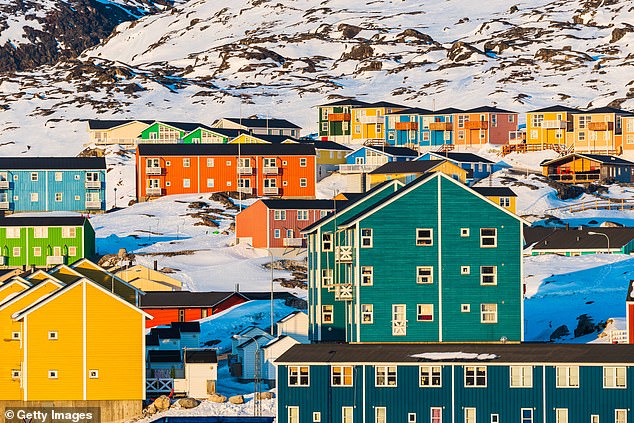Greenland has long been known for its breathtaking, snow-topped landscapes, but now the world is focusing on something else entirely – the fascinating meaning behind its colour-coded buildings.
The Arctic territory has taken centre stage over recent months amid growing political tensions with US President Donald Trump, after he pledged to take control of the island.
But as US Vice President JD Vance and his wife, Usha, were met with a chilly reception during their controversial visit to Greenland today, the nation’s bright, eye-catching buildings have also caught the attention of curious observers.
At first glance, the brightly painted houses in hues of red, yellow, green, blue, and black may seem like nothing more than a picturesque Instagram backdrop.
However, these coloured buildings actually serve as a fascinating and integral system that dates back to the 18th century.
The origins of the colour-coded buildings can be traced back to Greenland’s colonial era, when Scandinavian settlers arrived and brought with them timber kits for building wooden houses.
At that time, street names and house numbers were non-existent, so the colours of the buildings were used as a practical way to distinguish between different types of structures.
According to Ujammiugaq Engell, a historian at the Greenland National Museum and Archives, each colour had a specific purpose.

Greenland has long been known for its breathtaking, snow-topped landscapes, but now the world is focusing on the fascinating meaning behind its colour-coded buildings

At first glance, the brightly painted houses in hues of red, yellow, green, blue, and black may seem like nothing more than a picturesque Instagram backdrop – but there’s a deeper meaning

In the 1700s, the colours of the buildings were used as a practical way to distinguish between different types of structures
She told MailOnline Travel: ‘Red was by far the most predominantly used colour as it represented not only the church but also a trade.
‘This meant that all buildings that were related to either of those things, whether it was the actual church or shop or the house in which the priest, shop owner or clerk lived, would be painted red.’
‘Later on the trade shifted over to its own colour and started favouring black.
But that wasn’t the only colour with symbolic significance, as she added: ‘Yellow originally represented anything health-related. All hospitals were painted yellow as were the houses where doctors and nurses lived.’
Green, on the other hand, was associated with communication, particularly radio and later telecommunications.
Over time, green became the defining colour for telecommunications buildings as personal communication devices evolved.
Then there’s blue, a colour often seen on buildings associated with the Greenlandic Technical Organisation (GTO) and factories.
This system, which helped identify the purpose of each building, was an efficient solution to the lack of street names and house numbers.

The colourful houses of Greenland look stunning on the icy landscape. Pictured is Qaqortoq

Red usually denoted that a building was a shop or church, yellow was a hospital or the house of a doctor or nurse and blue buildings were usually factories. Pictured is Ilulissat

This colour-coded system, which helped identify the purpose of each building, was an efficient solution to the lack of street names and house numbers in the 18th century
While the system was never ‘completely rigid,’ with some buildings being painted in these colours despite not serving the assigned purpose, the structure helped bring order to a developing society.
She added: ‘As the colour coordinating system was never completely rigid there have almost always been houses and buildings in the aforementioned colours that were not in any way related to the different trades.
‘It was, after all, quite difficult to come by paint in colonial-day Greenland, so one had to make do with any colours at hand.
‘There are a few things that have stuck around today though. The hospitals here are still yellow and the cathedral of Greenland is still red.’
Although owners today are free to paint their abode in any colour they choose, these historical coloured buildings have remained a charming, functional legacy from Greenland’s past – while adding a vibrant contrast to its stunning icy landscape.
This article was originally published by a www.dailymail.co.uk . Read the Original article here. .


